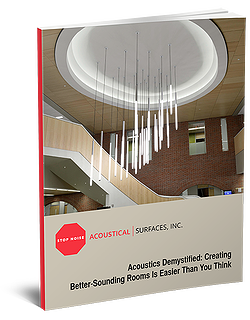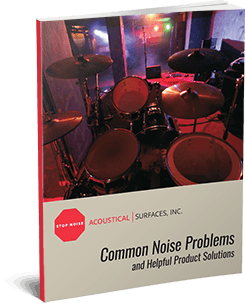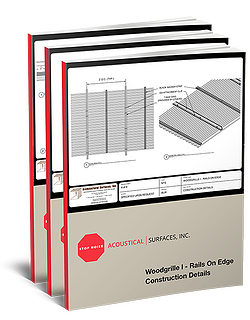Optimizing Event Venue Acoustics for Superior Sound and Privacy
Depending on a venue’s acoustics, a high-priced event can end with guests walking away with fantastic memories… or with a headache. In fact, poor sound design can turn a concert into muddled noise or an anniversary party into raised voices and frustratingly difficult conversations.
That’s where professional acoustics planning comes in. With the right preparation, you can scatter, absorb, target, and control sound in your live venue with a mixture of building fittings, equipment placement, and treatments like acoustic panels, clouds and baffles, diffusers, and drapes.
Whether you’re a manager of venues or the events that take place at them, understanding how sound works and how to improve venue acoustics will ensure you send every guest away ready to recommend your services.
Defining a Space: The Physics of Acoustics
When we produce sounds of any kind, it creates waves that project outward and are either absorbed or reflected by the surfaces they come into contact with. The way these waves interact with their environment define the acoustics of a space.
If your venue includes wide-open spaces with hard resorption surfaces, those waves will take time to reach the surfaces before reflecting back, thus creating an echo. When these sounds build up in the room, the reverberation causes the sounds to amplify or become louder.
All kinds of audio issues can arise when your venue isn’t set up to handle the sound waves created by the events you are producing. If you don’t address the acoustics and implement event sound control measures, you may find your guests shouting over one another or flinching as they listen to a performance riddled with audio problems.
Analyze Your Venue’s Acoustic Profile
Before you fix the problem, you need to define it. This is done by professionals who analyze and build a sound plan using these objective acoustic markers:
- Sound level
- Frequency balance
- Reverberation time
- Sound mapping
- Dead spots
These are measured by tools including:
- Sound pressure level (SPL) meter
- Frequency response analysis
- Reverberation time (RT60) meter along with a tape measure and laser pointer
- Impulse response testing device
- Specialty room acoustics testing equipment and software
Core Factors Influencing Venue Acoustics
Every different room is going to present a unique acoustical challenge. Acoustic design is informed by:
- Type and goals of an event (performance, socializing, etc.)
- Location and amplification of sound sources
- Distance to and direction of a crowd or audience
The physical factors influencing acoustics are:
- Shape and size of a room or environment
- Materials used in the structure and finishes of a building
- Location and nature of ceiling, walls, and other barriers
- Interior furnishings and surface fittings
Concert Hall
Concert venues known for the best acoustics are the gold standard for live shows. Their sound designers understand how to mitigate crowd noise, enormous spaces, hard surfaces, and multidirectional sound targeting to create a musical experience that makes every ticketed seat worth the price.
Theaters, auditoriums, and stadiums are conceived and created with acoustics in mind, from structural shape to materials and finishes. But not all venues have this head start—some begin as bars, restaurants, or warehouses. Retrofitting a space that wasn’t originally designed with concert acoustics in mind takes time, planning, and expertise,
In a concert or performance venue, the primary source of sound waves is the stage. You’ve also typically got a fairly large room with high ceilings and solid walls. This scenario is a recipe for reverberation. Also, if the side walls run parallel to each other, they can cause intrusive flutter echoes.
Indoor Venues for Weddings, Dinners, and Corporate Events
When venues cater to weddings and corporate events, they have a different set of needs. The focus of these events is really on the gathering itself rather than the entertainment. It’s much more important that individual attendees are able to converse comfortably at these types of events.
Venues with good acoustics are much more likely to attract repeat business, so it’s essential to make sure yours isn’t driving them away.
Venues dedicated to gatherings are generally large, open spaces, so you’ll run into some similar issues to concert venues. The main difference here is that the primary source of your sounds is usually the crowd of people chatting it up with one another. You may have a band or DJ, but it’s a much different situation than a concert—it’s likely less of a focal point.
A great way to reduce reverberation in wedding and corporate event venues is to add acoustic panels near the eye level of the average patron. These panels will absorb many of the speech sound waves, reducing the reverberation and amplification of the various conversations. They also look great, adding texture and a pop of color to the walls.
Another excellent solution for this type of room is the installation of acoustical ceiling clouds. They definitely help create a point of interest since the many shapes, patterns, and finishes create eye-popping visuals that take the place of your HVAC and utility hardware.
They’ll absorb sounds from the group in the room, but they’ll also minimize noise caused by all that ceiling-mounted hardware. The result is a great-looking space where event guests can stretch comfortable conversations into the night rather than heading home to nurse a headache.
Outdoor Venues
Outdoor venues are their own acoustic challenge. While the same laws of acoustics are in play, the physical room is gone. Presenters need to understand the surrounding landscape in a different way than they do in enclosed spaces.
If the speakers face objects like large buildings or rock formations, you will likely experience echo. This isn’t necessarily a bad thing, but it’s something to take into consideration. Natural amphitheaters are actually chosen for the amplification and echo that occurs within the surrounding landscape.
Since you can’t move buildings and rock formations, the easiest way to create excellent acoustics in an outdoor performance venue may again be to play with the angle of your speakers. Small changes in the dispersion pattern of sound waves can make all the difference between great sound and noise. Be sure to play with the sound when no patrons are present so you can find the sweet spot before guests arrive.
Comprehensive Solutions for Acoustic Improvement
Coming up with an effective sound plan for each unique environment is essential for providing the right experience in the right space.
In most situations, you can improve venue acoustics by scattering sound waves in some spots and absorbing them in others. Your main modes of scattering and absorbing sounds are going to be acoustic panels, echo reducing panels, sound diffusers, outdoor sound absorbing panels, and other furnishings.
Details as simple as setting down a rug or introducing soft furnishings like couches and chairs can noticeably improve the venue acoustics, but incorporating professional acoustical products is a game-changer.
Consider these solutions and tools:
- Speaker placement – Face speakers toward the crowd centerpoint to deliver the purest sound and reduce the intensity of sound waves bouncing off the back wall. If you have the means, ideal placement involves raising the speakers by suspending them from the ceiling to face down toward the crowd, which will also eliminate the direct sound reflection off the back wall.
- Acoustical panels – Wall and ceiling panels and tiles of varying materials and thicknesses absorb sound waves, particularly in mid to high frequency noise.
- Bass traps – Typically placed in corners (floor and ceiling) and behind speakers, bass traps are similar to acoustical panels but they’re specifically designed to treat low-frequency sound problems and smooth out music.
- Sound diffusers – Used on ceilings or walls, sound diffusers have smooth, curved surfaces to help direct and control the traveling of sound waves.
- Acoustical ceiling baffles and clouds – Available in unique shapes, colors, sizes, and materials, free-hanging ceiling clouds and baffles help absorb and direct sound. They also reduce noise by covering metallic ceiling pipes and utility structures and limiting any flutter echo.
- Drapes – Indoor and exterior curtains and drapes are useful tools to help separate spaces, absorb and diffuse sound, and enhance structures and materials not originally designed with top-notch acoustics.
- Custom solutions – From a custom graphic acoustic panel to a bespoke solution that blends materials, shapes, and elements exactly for your unique venue.
Improve Your Venue Acoustics with Acoustical Surfaces
Not all venues easily fit into a given category—some include both indoor and outdoor venues, multiple defined areas, or odd shapes. If you’re someone who hosts multiple types of events in various venues, it can be difficult to pinpoint the acoustic treatment for your needs. After all, great sound is a puzzle and an art.
Whether you know how to create balanced sound in your venue space or need help designing a plan, Acoustical Surfaces is the right partner to work with. We have the experience and expertise to help you solve any issues you’re having with your venue acoustics.
Remember, your event venue will only be as good as its acoustics design. And bad sound can turn a once-in-a-lifetime event into audible chaos and spent vocal cords. Keeping your events and venues on the hot ticket list starts with a comprehensive sound design and noise management plan. We’d love to help you with that.
Contact our experts today to discuss how our vibration and sound absorption, blocking, treatment, and proofing solutions can get the results you need.
Sources:
- Underground Talent. Room Acoustics: How to Test the Acoustics of Your Room? https://undergroundtalent.co.uk/room-acoustics-how-to-test-the-acoustics-of-your-room/




